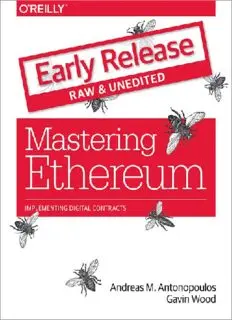
What Is Ethereum?
Ethereum is often described as "the world computer.” But what does that mean? Let’s start with a
computer science–focused description, and then try to decipher that with a more practical analysis
of Ethereum’s capabilities and characteristics, while comparing it to Bitcoin and other
decentralized information exchange platforms (or "blockchains" for short).
From a computer science perspective, Ethereum is a deterministic but practically unbounded state
machine, consisting of a globally accessible singleton state and a virtual machine that applies
changes to that state.
From a more practical perspective, Ethereum is an open source, globally decentralized computing
infrastructure that executes programs called smart contracts. It uses a blockchain to synchronize
and store the system’s state changes, along with a cryptocurrency called ether to meter and
constrain execution resource costs.
The Ethereum platform enables developers to build powerful decentralized applications with built-
in economic functions. While providing high availability, auditability, transparency, and neutrality,
it also reduces or eliminates censorship and reduces certain counterparty risks.
Compared to Bitcoin
Many people will come to Ethereum with some prior experience of cryptocurrencies, specifically
Bitcoin. Ethereum shares many common elements with other open blockchains: a peer-to-peer
network connecting participants, a Byzantine fault–tolerant consensus algorithm for
synchronization of state updates (a proof-of-work blockchain), the use of cryptographic primitives
such as digital signatures and hashes, and a digital currency (ether).
Yet in many ways, both the purpose and construction of Ethereum are strikingly different from
those of the open blockchains that preceded it, including Bitcoin.
Ethereum’s purpose is not primarily to be a digital currency payment network. While the digital
currency ether is both integral to and necessary for the operation of Ethereum, ether is intended
as a utility currency to pay for use of the Ethereum platform as the world computer.
Unlike Bitcoin, which has a very limited scripting language, Ethereum is designed to be a general-
purpose programmable blockchain that runs a virtual machine capable of executing code of
arbitrary and unbounded complexity. Where Bitcoin’s Script language is, intentionally, constrained
to simple true/false evaluation of spending conditions, Ethereum’s language is Turing complete,
meaning that Ethereum can straightforwardly function as a general-purpose computer.
Components of a Blockchain
The components of an open, public blockchain are (usually):
A peer-to-peer (P2P) network connecting participants and propagating transactions and blocks
of verified transactions, based on a standardized "gossip" protocol
Messages, in the form of transactions, representing state transitions
A set of consensus rules, governing what constitutes a transaction and what makes for a valid
state transition
A state machine that processes transactions according to the consensus rules
A chain of cryptographically secured blocks that acts as a journal of all the verified and
accepted state transitions
A consensus algorithm that decentralizes control over the blockchain, by forcing participants to
cooperate in the enforcement of the consensus rules
A game-theoretically sound incentivization scheme (e.g., proof-of-work costs plus block rewards)
to economically secure the state machine in an open environment
One or more open source software implementations of the above ("clients")
All or most of these components are usually combined in a single software client. For example, in
Bitcoin, the reference implementation is developed by the Bitcoin Core open source project and
implemented as the bitcoind client. In Ethereum, rather than a reference implementation there is a
reference specification, a mathematical description of the system in the Yellow Paper (see Further
Reading). There are a number of clients, which are built according to the reference specification.
In the past, we used the term "blockchain" to represent all of the components just listed, as a
shorthand reference to the combination of technologies that encompass all of the characteristics
described. Today, however, there are a huge variety of blockchains with different properties. We
need qualifiers to help us understand the characteristics of the blockchain in question, such as
open, public, global, decentralized, neutral, and censorship-resistant, to identify the important
emergent characteristics of a "blockchain" system that these components allow.
Not all blockchains are created equal. When someone tells you that something is a blockchain, you
have not received an answer; rather, you need to start asking a lot of questions to clarify what they
mean when they use the word "blockchain." Start by asking for a description of the components in
the preceding list, then ask whether this "blockchain" exhibits the characteristics of being open,
public, etc.
The Birth of Ethereum
All great innovations solve real problems, and Ethereum is no exception. Ethereum was conceived
at a time when people recognized the power of the Bitcoin model, and were trying to move beyond
cryptocurrency applications. But developers faced a conundrum: they either needed to build on top
of Bitcoin or start a new blockchain. Building upon Bitcoin meant living within the intentional
constraints of the network and trying to find workarounds. The limited set of transaction types,
data types, and sizes of data storage seemed to limit the sorts of applications that could run
directly on Bitcoin; anything else needed additional off-chain layers, and that immediately negated
many of the advantages of using a public blockchain. For projects that needed more freedom and
flexibility while staying on-chain, a new blockchain was the only option. But that meant a lot of
work: bootstrapping all the infrastructure elements, exhaustive testing, etc.
Toward the end of 2013, Vitalik Buterin, a young programmer and Bitcoin enthusiast, started
thinking about further extending the capabilities of Bitcoin and Mastercoin (an overlay protocol
that extended Bitcoin to offer rudimentary smart contracts). In October of that year, Vitalik
proposed a more generalized approach to the Mastercoin team, one that allowed flexible and
scriptable (but not Turing-complete) contracts to replace the specialized contract language of
Mastercoin. While the Mastercoin team were impressed, this proposal was too radical a change to
fit into their development roadmap.
In December 2013, Vitalik started sharing a whitepaper that outlined the idea behind Ethereum: a
Mastering Ethereum by Andreas M. Antonopoulos and Gavin Wood




